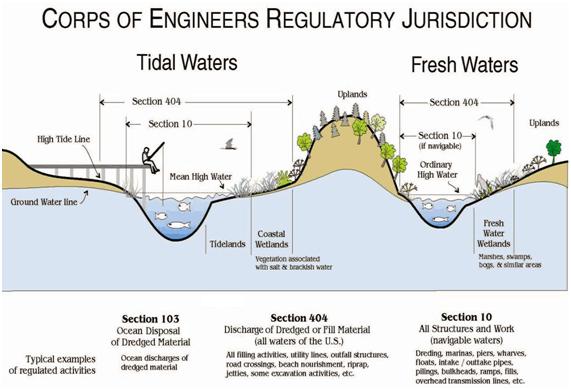For further information on Corps Jurisdiction, please visit any of our related pages to the right. Information on how to request JD related services can be found on our Apply for a permit or JD page to the right.
Two federal statutes mandate the Corps jurisdiction over navigable waterways and adjacent wetlands. These are Section 10 of the Rivers and Harbors Act of 1899 and Section 404 of the Clean Water Act. Section 10 of the Rivers and Harbors Act of 1899 to all navigable waters of the United States and Section 404 of the Clean Water Act applies to all waters including wetlands that have sufficient nexus to interstate commerce. The diagram below illustrates the lateral limit where Section 10 and Section 404 apply.

Savannah District has three approaches to complete a jurisdictional determination (JD) for the purpose of establishing jurisdiction pursuant to Section 10 of the Rivers and Harbors Act of 1899 (33 USC 403) and Section 404 of the Clean Water Act (33 USC 1344): An Aquatic Resources Delineation Review (ARDR), a Preliminary JD and an Approved JD.
WOTUS News:
On September 8, 2023, the Environmental Protection Agency and the U.S. Department of the Army (agencies) issued a final rule to amend the January 2023 Rule, to conform the definition of "waters of the United States" to the Supreme Court’s decision in Sackett v. Environmental Protection Agency (Sackett). This conforming rule amends the provisions of the agencies’ definition of "waters of the United States" that are invalid under the Supreme Court’s interpretation of the Clean Water Act in the Sackett decision. However, as a result of ongoing litigation on the January 2023 Rule, in the 27 states (including Georgia) and for certain parties, the agencies are interpreting "waters of the United States" consistent with the pre-2015 regulatory regime and the Sackett decision until further notice (https://www.epa.gov/wotus/definition-waters-united-states-rule-status-and-litigation-update; https://www.epa.gov/system/files/documents/2023-10/2023-joint-coordination-memo-pre-2015-regulatory-regime_508c.pdf). Additional information regarding the rule is available on EPA's website at https://www.epa.gov/wotus.
Announcements, tools, and other technical materials:
https://www.usace.army.mil/Missions/Civil-Works/Regulatory-Program-and-Permits/
https://www.usace.army.mil/Missions/Civil-Works/Regulatory-Program-and-Permits/juris_info/
https://www.usace.army.mil/Missions/Civil-Works/Regulatory-Program-and-Permits/techbio/
https://www.usace.army.mil/Missions/Civil-Works/Regulatory-Program-and-Permits/Related-Resources/CWA-Guidance/